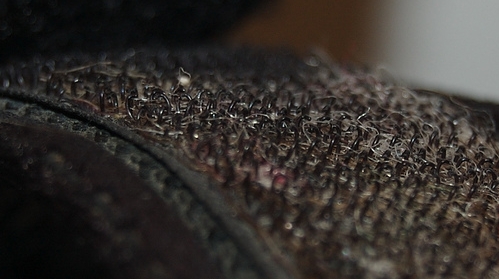
The first time I read about the invention of Velcro was in the third grade. The book said that in 1941 engineer George de Mestral went on a hunting trip and when he came back was fascinated by the burrs that were stuck to his jacket and his dog’s fur. He checked out the burrs in a microscope, and noticed they had little hooks at the end of each spike to help them attach to the fibers in his jacket. In a flash of genius, Mestral thought that it’d be a great idea to create an adhesive based on the same principle. Shortly thereafter, he created a prototype and soon Velcro was so popular that Mestral became filthy rich overnight.
For the longest time that’s all I thought there was to the invention of Velcro. It was only until recently that I found there was much more to the story.
George de Mestral didn’t just have the idea, slap together a prototype in his shed, sell it, and suddenly become rich. In reality, the invention of Velcro was not an overnight success, but rather a 20 year struggle. Although I found the story to be far removed from the fairy tale I read long ago, I found the true story of Velcro to be far more inspirational.
The (true) story of Velcro
After he had been blessed (some might say “cursed”) with his brilliant idea, Mestral visited one weaver after another to try to convince one of them to make a prototype. At first, no one took him seriously or even bothered to listen to him. Eventually, through sheer stubbornness and persistence, he managed to persuade one weaver to help him out.
Although he managed to acquire the means of making a prototype, Mestral couldn’t find the right material to achieve the adhesive quality he was looking for. The idea was simple enough: Hooks on one end, loops on the other, but try as he might, he couldn’t find a material strong enough for the hooks.
After years of trial and error, Mestral settled on nylon (a recent invention) as his material of choice. Although nylon, as strong as it was, seemed like the perfect material for the hooks, there was no known manufacturing process that could automate their production.
After all those years of struggle, his invention seemed doomed.

But Mestral couldn’t let his idea go. He sacrificed everything he had, quit his job and borrowed money from friends to make Velcro come to life. He devoted himself to inventing a machine that could cut the uniform nylon hooks he had envisioned. During this difficult time Mestral was fond of repeating a quote from one of his friends: “There are two paths of ruin for men: women and inventions, inventions being the more certain path.”
After nearly a decade of obsessing over these hooks, he almost gave up. In a final move of desperation he retreated to a hut deep in the Alps where he’d be free from distractions. After days of fruitless meditation he went to a nearby town for a change of scene. While waiting in the local barbershop, Mestral had a flash of inspiration: he could create a machine that simulated the cutting motion of the barber’s shears, and thus cut the uniform nylon hooks that he was looking for.
So finally, nearly 14 years after getting his initial idea, Mestral had a patent and a manufacturing process. The product was complete. All he had to do now was present it to the world and deal with the overwhelming demand, right?
Well…not exactly.
Velcro Fails to Stick
Mestral was an Engineer, and engineers aren’t particularly known for their fashion savvy. To Mestral, all that mattered was the function of the product, not the form. Here was a product that didn’t break like zippers did or fall off like buttons did. Obviously the function was far superior. How could there NOT be demand?
Mestral failed to recognize that fashion was a strange world where form rules over function. Velcro, unfortunately, was high on function and low on form. It looked like ragged pieces of cloth and certainly couldn’t capture the flair that fancy buttons and laces had.
Although it was a brilliant idea, it seemed that the fashion world wouldn’t have anything to do with it. And since the only apparent application of this adhesive was clothing at the time, Velcro seemed to be doomed to a death of obscurity.
A Customer from Outer Space
It wasn’t until NASA decided to use Velcro as fasteners for spacesuits that the orders started coming in. Shortly thereafter some smart sporting goods designer saw how the same idea could be applied to ski apparel and from there the invention took off. Once people started to see applications for the adhesive other than in high-fashion, it wasn’t too soon before Velcro made its way into child wallets and Spider Man sneakers. Now it’s used in everything from child-safe dart boards to the cuffs in blood pressure meters.
After more than 20 years of hard work and battling with uncertainty (some might say unreadiness ;)), Velcro became the “overnight success” that the book I had read so long ago had led me to believe. Eventually Mestral made a lot of money from his invention, but I’m sure that doesn’t compare to the satisfaction he got from bringing his idea to life.
The Lessons I Learned from this Story:
Don’t Throw Away a Good Idea
The book I read in grade school about successful inventors was really nothing more than a collection of entrepreneurial folk tales. The message of the book was poisonous: All you had to do was come up with a great original idea, sell it, and *poof* you’re a millionaire!
Obviously, nothing could be further from the truth.
Many good ideas die because, after putting forth a little effort, nothing fruitful comes of it. Because we don’t get instant results from our good ideas we tend to believe that the idea would have never worked. One thing I learned from Mestral is that this isn’t true. Even a seemingly stupid idea like Velcro can be wildly successful if you put enough effort behind it.
Velcro was a very good idea that required a lot of hard work and dedication to make a reality. I believe that most of us have several ideas over the course of our lives that can not only make us rich, but also help a lot of people. Don’t throw your good ideas away. Realize their value.
Know what your customers want
Although Mestral undoubtedly had genius, passion and drive, he failed to understand the motivations of the fashion industry. He naturally assumed that his superior adhesive would be favored over buttons and zippers without thinking about how ugly Velcro was. If he had tried to adopt the mindset of a fashion designer he probably would have realized very quickly that his invention wouldn’t be well received. If he made this realization sooner, he might have spent more time thinking of other markets that might have wanted his product than making overtures to an industry that clearly didn’t want anything to do with it.
Ideas don’t make money, their applications do.
Products, no matter how ingenious they might be, are worthless unless you can find applications for them that people are willing to pay for. Velcro was considered useless until NASA found a use for it. If NASA spacesuit designers had decided to use zippers instead, we may have never even heard of Velcro.
It’s very possible that even today you could come up with an application for Velcro that could make you a million dollars. All you have to do is think of a unique way to use Velcro to make people’s lives easier. You don’t have to be 100% original either. After all, it doesn’t take an inventor genius to make the logical jump from space suits to ski suits.
Furthermore, that ski suit designer probably didn’t have to work as hard to make his fortune as Mestral did.
There are many unsuccessful ideas out there that have died for want of a good application. I imagine some of those ideas are your own. Maybe it’s time to take a look at them again. If you can come up with some good applications, you may just turn an unsuccessful idea into a very successful one.
Why not give it a try?
Photo Credits:
First photo by: Beatrice Murch
Second photo by: Kim Laughton
Did you like this article? Would be willing to donate some loose change in appreciation of it? Check out this article’s goldhat page to see who already has.